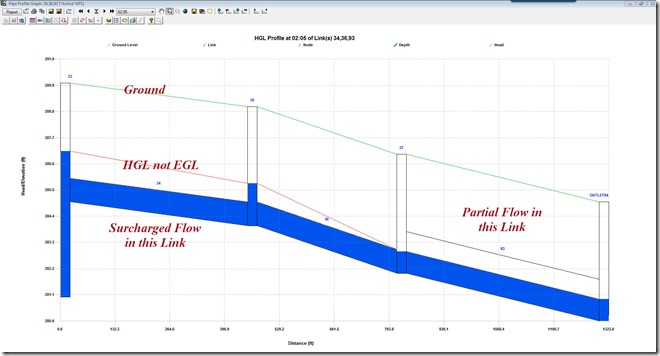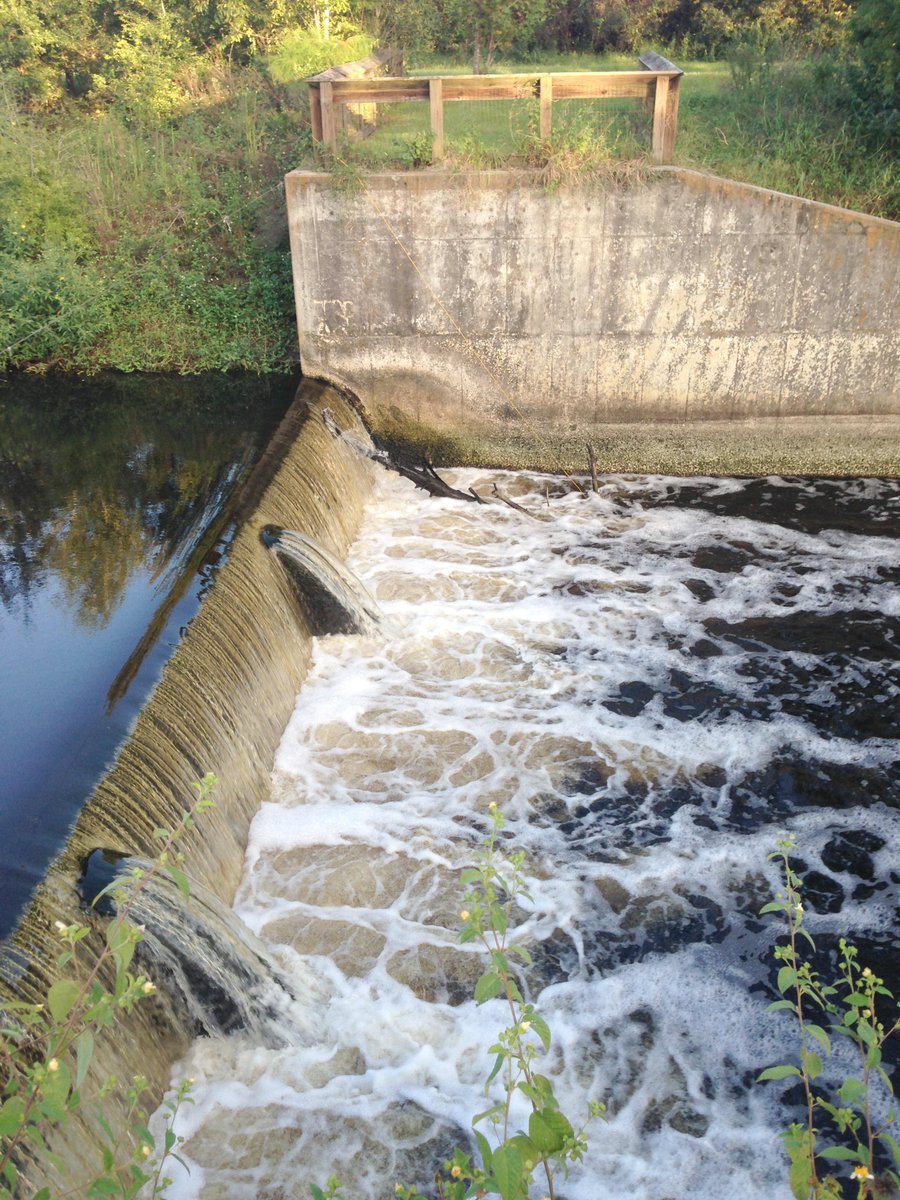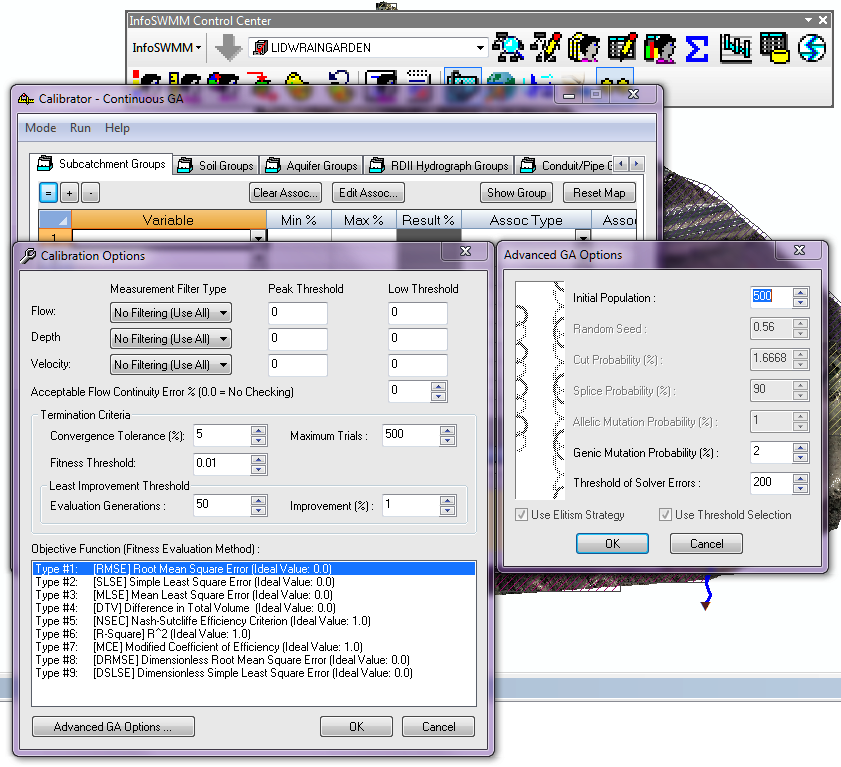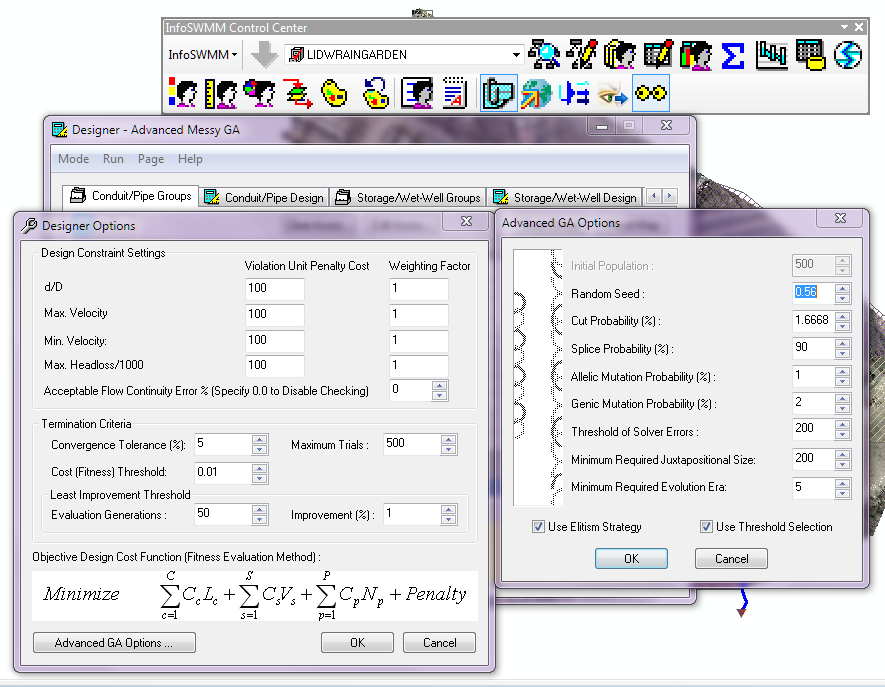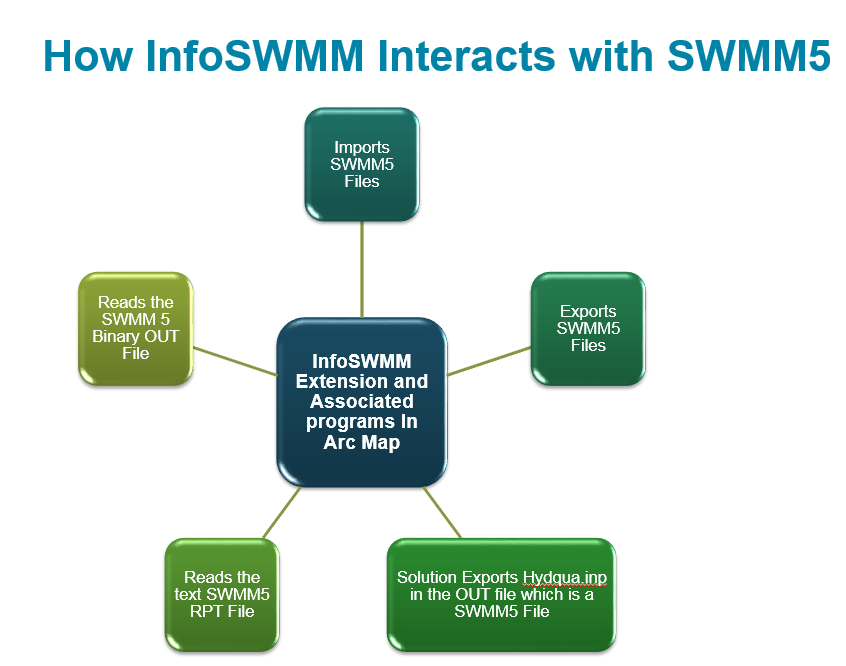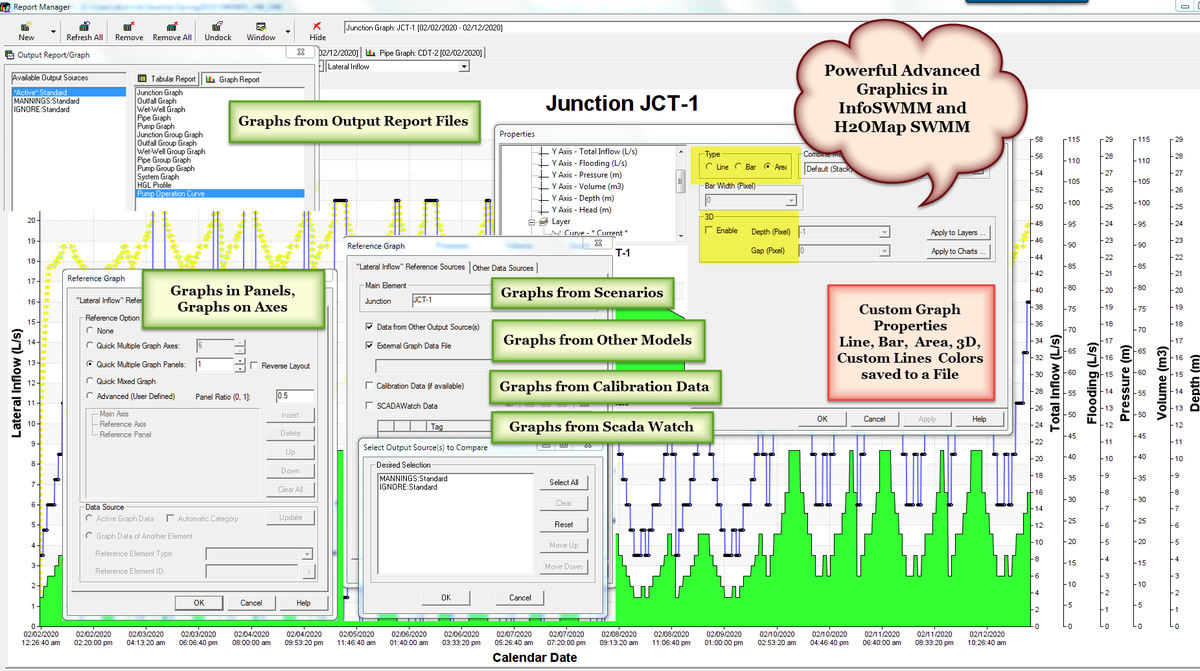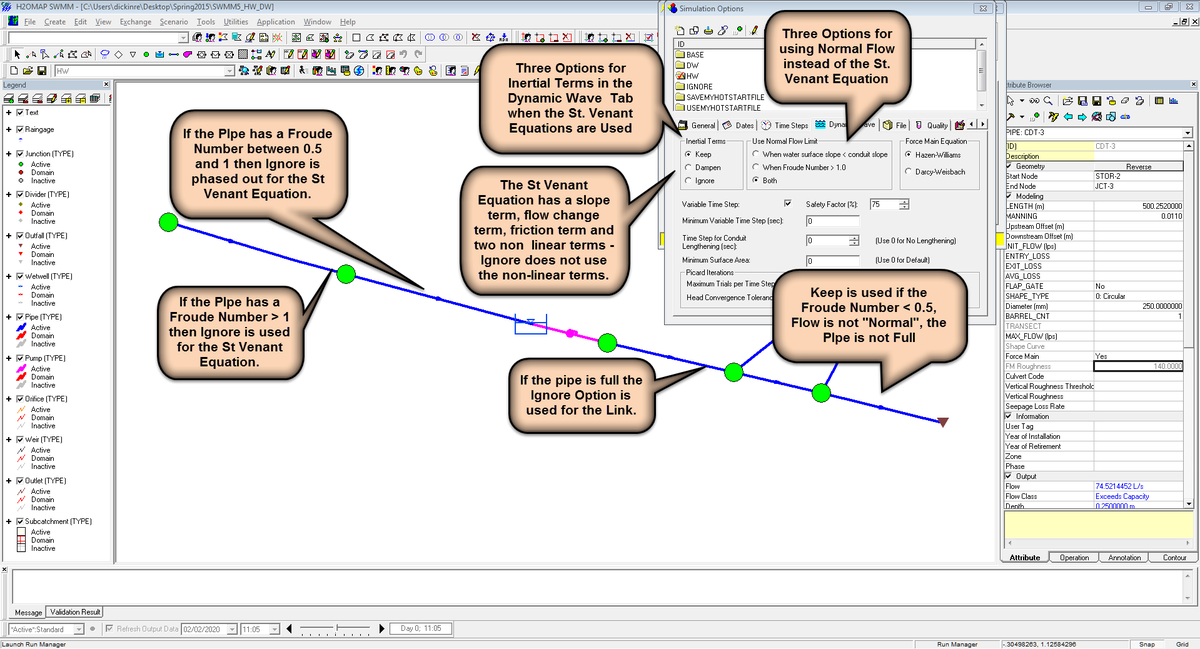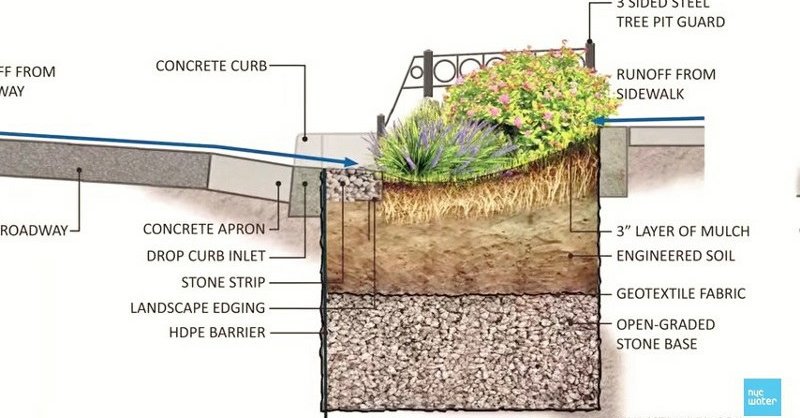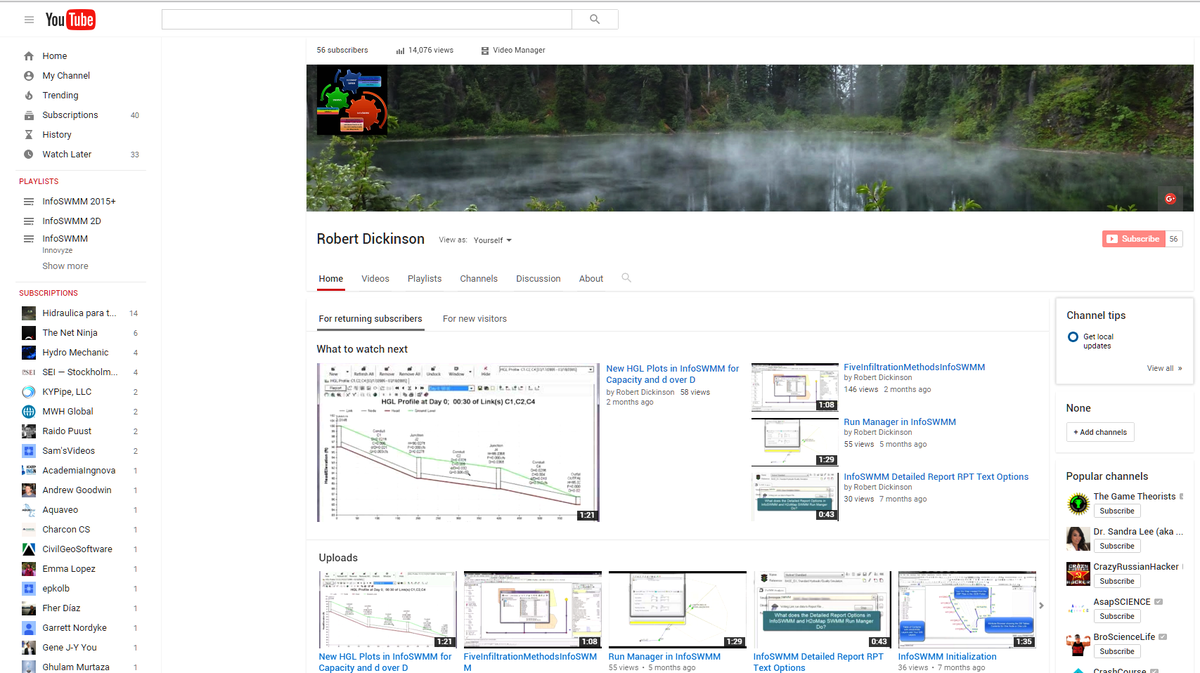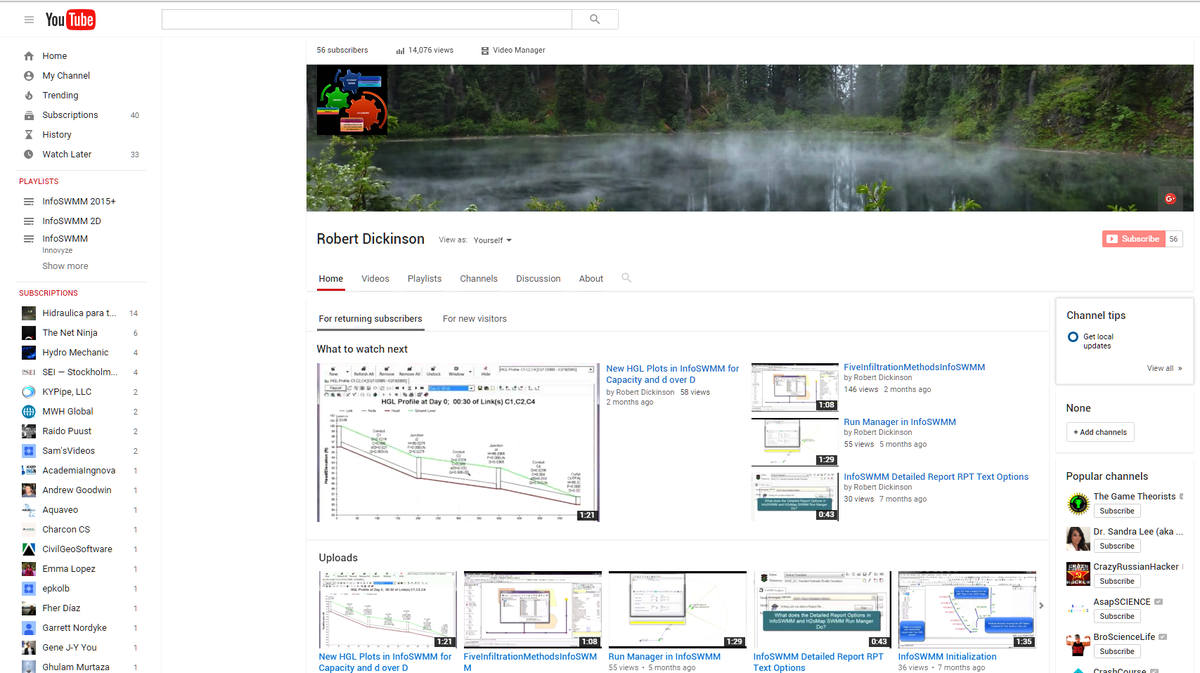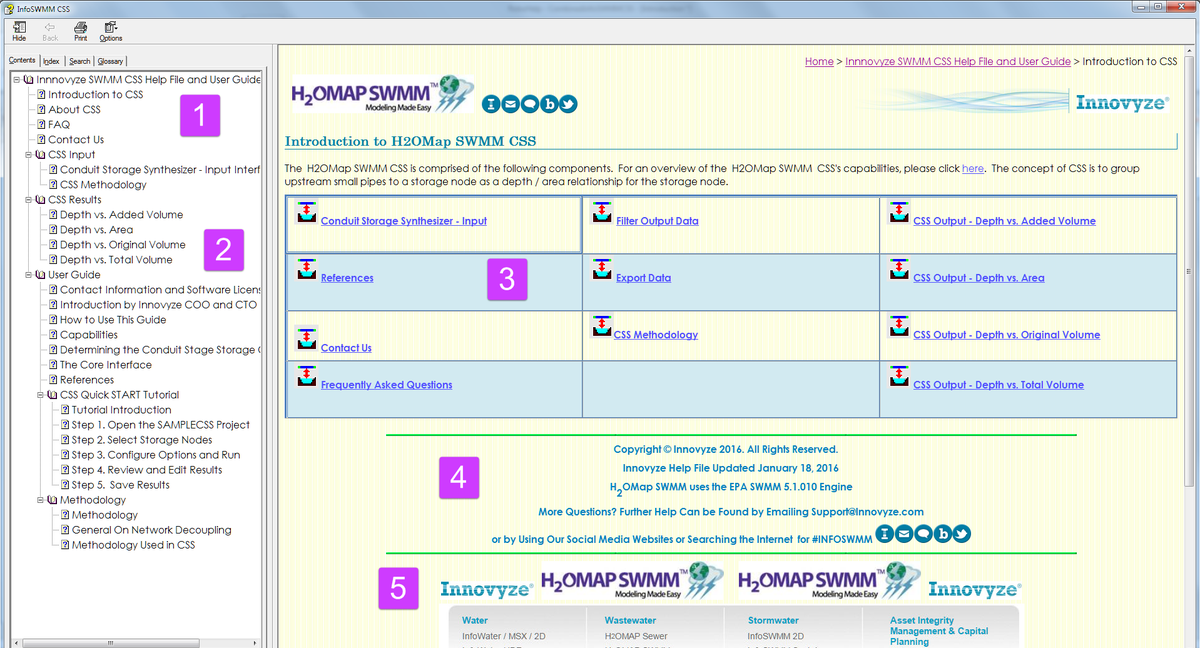Updated - Innovyze St Venant Solutions for InfoSWMM, InfoSewer, H2OMap SWMM and InfoWorks ICM and InfoWorks ICM SE
1. Assumptions for the St. Venant Equations
The assumptions behind Lumped and Distributed Models along with the assumptions of the St Venant Equations. InfoSWMMH2OMap SWMM, InfoSWMM, H2OMap SWMM, SWMM5, ICM and ICM SE are all Distributed models for Unsteady flow. InfoSWMM and InfoSWMMH2OMap SWMM have options for direct steady flow. ICM and InfoSWMM can also use a quasi steady flow solution. All of these Innovyze models use the Continuity Equation and Momentum equation for routing flows in links. The numerical solution differs between the three Innovyze main platforms:
Continuity Equation
Various Forms of the Momentum Equation
2. Muskingum-Cunge for InfoSewer and H2OMap Sewer ![image1138[2] image1138[2]](https://lh3.googleusercontent.com/blogger_img_proxy/AEn0k_vLLmszVyEEMy4UdlX5KyiTVr5vJO3HFBwSQPI00NWpRQV54WU-CE47weuopLOUn-PmO6yKvWnpgkXctmIYZg47TMRO1lTSd2AdLSsFosJ20seRFCH4OamEHRlI5CwjtNY=s0-d)
The continuity (mass conservation) equation is:
where
x = distance along the pipe (longitudinal direction of sewer)
A = flow cross-sectional area normal to x
y = coordinate direction normal to x on a vertical plane
d = depth of flow of the cross section, measured along y direction
Q = discharge through A
V = cross-sectional average velocity along x direction
S0 = pipe slope, equal to sin θ
θ = angle between sewer bottom and horizontal plane
Sf = friction slope
g = gravitational acceleration
t = time
β = Boussinesq momentum flux correction coefficient for velocity distribution
These complete unsteady flow equations (momentum together with continuity) along with appropriate initial and boundary conditions are rather tedious and computationally expensive to solve, especially for large sewer collections systems. As a result, acceptable simplifications and improved solution methods have been proposed including non-inertial, kinematic wave and dynamic wave simplifications. Hydraulically, the dynamic wave approach is the most accurate model among the approximations. The Muskingum-Cunge explicit diffusion wave dynamic flow routing model, obtained by neglecting local acceleration term in the momentum equation, is the most commonly used dynamic wave model.
In InfoSewer /H2OMap Sewer Pro![image1138[3] image1138[3]](https://lh3.googleusercontent.com/blogger_img_proxy/AEn0k_ue-KzoeUYIsNaCZcEqXbKa7eCEZn8sZ1qFYDQQBx795Aju8sn3fhIx4v_xkZb3kzFFYb5SiOQz8HQRLdc6Zo_o0E1HhxP_NKTzjA5dHGnDN_9kNNlJrdt2yx1rYTn-sh4=s0-d) unsteady open channel (free surface) flow is simulated using Muskingum-Cunge technique whereas pressurized flow in any pipe is modeled assuming the pipe is flowing full and the energy equation is applied to the entire pipe section.
where
Here c is the dynamic wave celerity and B is the top width at normal depth for discharge Q. This highly efficient and accurate flow routing algorithm is used by InfoSewer /H2OMap Sewer Pro to track the spatial and temporal variation of flows throughout the collection system.
In this method (a.k.a., one sweep explicit solution method), the network flow dynamic equations are formulated by using an explicit finite difference scheme such that the flow depth, discharge, or velocity at a given location and the current time can be solved explicitly from the known information at the previous locations at the same time level, as well as known information at the previous time level. Thus, the solution is obtained segment by segment, pipe by pipe, over a given time interval for the entire sewer network before progressing to the next interval for another sweep of individual solutions of the network flow equations for the entire network. A variable time step approach (based on the Courant number
unsteady open channel (free surface) flow is simulated using Muskingum-Cunge technique whereas pressurized flow in any pipe is modeled assuming the pipe is flowing full and the energy equation is applied to the entire pipe section.
where
Here c is the dynamic wave celerity and B is the top width at normal depth for discharge Q. This highly efficient and accurate flow routing algorithm is used by InfoSewer /H2OMap Sewer Pro to track the spatial and temporal variation of flows throughout the collection system.
In this method (a.k.a., one sweep explicit solution method), the network flow dynamic equations are formulated by using an explicit finite difference scheme such that the flow depth, discharge, or velocity at a given location and the current time can be solved explicitly from the known information at the previous locations at the same time level, as well as known information at the previous time level. Thus, the solution is obtained segment by segment, pipe by pipe, over a given time interval for the entire sewer network before progressing to the next interval for another sweep of individual solutions of the network flow equations for the entire network. A variable time step approach (based on the Courant number  is used to minimize numerical dispersion and ensure robustness and stability of the numerical scheme. Complex flow attenuation calculations can be explicitly carried out to more accurately simulate the movement and transformation of sanitary sewer flows in the collection system.
An excellent review and comparison between simulated and observed hydrographs of the various numerical methods for solving unsteady flow in simple and compound channels was presented by Chatila (Chatila 2003). In terms of overall performance, the Muskingum unsteady solution scheme compared favorably and proved to be a simple and reliable method avoiding complicated mathematical and numerical computations for the cases considered.
Flooding at manholes and wet wells in InfoSewer /H2OMap Sewer Pro is not modeled during an extended period dynamic simulation. Instead, the flows at the flooded structures are conserved and are not lost by the occurrence of flooding at the manholes. In actual flooding situations, flows may be diverted away from the flooded structures and out of the sewer collection system. However, a surcharged pipe or manhole is generally an indication of poor hydraulic performance of the sewer system. InfoSewer/Pro assumes that the downstream pipes of flooded manholes are flowing full.
Sanitary sewer systems are typically designed to flow less than full and have an upper-pressure limit of 4 to 6 psi. Sewer systems operating under pressurized flow condition may run the risk of violating local, state, and federal health codes. The USEPA regulations would also be in violation if raw sewage were discharged into the ground, potentially affecting groundwater. For these reasons, pressurized flows in sanitary sewers not designed to sustain pressures can be dangerous and in some cases can present an unlawful activity.
is used to minimize numerical dispersion and ensure robustness and stability of the numerical scheme. Complex flow attenuation calculations can be explicitly carried out to more accurately simulate the movement and transformation of sanitary sewer flows in the collection system.
An excellent review and comparison between simulated and observed hydrographs of the various numerical methods for solving unsteady flow in simple and compound channels was presented by Chatila (Chatila 2003). In terms of overall performance, the Muskingum unsteady solution scheme compared favorably and proved to be a simple and reliable method avoiding complicated mathematical and numerical computations for the cases considered.
Flooding at manholes and wet wells in InfoSewer /H2OMap Sewer Pro is not modeled during an extended period dynamic simulation. Instead, the flows at the flooded structures are conserved and are not lost by the occurrence of flooding at the manholes. In actual flooding situations, flows may be diverted away from the flooded structures and out of the sewer collection system. However, a surcharged pipe or manhole is generally an indication of poor hydraulic performance of the sewer system. InfoSewer/Pro assumes that the downstream pipes of flooded manholes are flowing full.
Sanitary sewer systems are typically designed to flow less than full and have an upper-pressure limit of 4 to 6 psi. Sewer systems operating under pressurized flow condition may run the risk of violating local, state, and federal health codes. The USEPA regulations would also be in violation if raw sewage were discharged into the ground, potentially affecting groundwater. For these reasons, pressurized flows in sanitary sewers not designed to sustain pressures can be dangerous and in some cases can present an unlawful activity.
 is used to minimize numerical dispersion and ensure robustness and stability of the numerical scheme. Complex flow attenuation calculations can be explicitly carried out to more accurately simulate the movement and transformation of sanitary sewer flows in the collection system.
is used to minimize numerical dispersion and ensure robustness and stability of the numerical scheme. Complex flow attenuation calculations can be explicitly carried out to more accurately simulate the movement and transformation of sanitary sewer flows in the collection system.
Surcharge ![image1138[5] image1138[5]](https://lh3.googleusercontent.com/blogger_img_proxy/AEn0k_sIISlGiufpLrQ0HQlsNU1C3bbfGHBq4tt1tlBie3LX0FhIiexxetzigymx36hzMo7j6nwZAD2uFm87r_qdelk4l7-7jNJpbe6GYHPJiHtBuXiT64E8U9k6oX_NWdUCInM=s0-d)
Sewer pipes can flow full with water under pressure, which is often known as surcharge flow. Surcharge flow occurs in under-designed pipes (or under extreme flows) when the flow rate Q exceeds the full pipe capacity Qf .
Flow conditions are unstable at the transition between open-channel (free surface) flow and full pipe flow. A wave or surge can induce full flow in the pipe in the unstable range. Surcharge in sewer pipes is modeled in InfoSewer /H2OMap Sewer Pro using energy and continuity principles. The energy equation between sections 1 and 2 in a pipe can be written as:
Here z denotes the invert elevation; d represents the water depth; and HL designates the head loss between sections 1 and 2. The energy equation is used to determine the difference in hydraulic grade line elevation (which is added at the upstream manholes) needed to pass downstream flows under the surcharge condition.
The procedure for analyzing surcharge in sewer pipes is illustrated using the figure below as a reference.
Assuming that pipe 4 (between manholes 4 and 5) is under-designed, Q4 will exceed its full flow capacity and the hydraulic grade line at manhole 4 will increase based on energy consideration to allow Q4 to pass through pipe 4 (note that water always flows from higher to lower energy) as continuity must be satisfied. This forces the hydraulic grade line at manhole 3 to increase in order for Q3 to pass through pipe 3. The procedure continues upstream until the slope of the energy grade line needed to transport the flow allows open-channel flow condition to occur in the pipe. The projected hydraulic grade line will then intersect the uniform water surface flow to complete the backwater curve.
The energy equation is also used to model the flow in siphons, which can occur in adverse pipes. InfoSewer assumes that the siphon flows full, with a continuous liquid column throughout it.
Flow Attenuation ![image1138[6] image1138[6]](https://lh3.googleusercontent.com/blogger_img_proxy/AEn0k_vvN-2khJsEd8O5ijQ5GXsum5afVHR-GzfqLSHuBksyHeiRc6wy2I0ynXkTxnhzdaKcywe_CKrhXWu_JHDyG0OrgcuDhSfkFKyuubQuTndjS9HCREzDUh9YQJ5G5oqJA-A=s0-d)
When a flow hydrograph is injected and propagates downstream in sewer pipes the bulk of the water will normally travel slower than its induced disturbance or wave. That is, if the water is injected with a tracer then the tracer lags behind the disturbance. The speed of the disturbance depends on parameters such as depth, width and flow velocity. This disturbance will tend to flatten, or spread out, the peak flow in the downstream direction along the sewer pipes.
Flow attenuation in a sewer system is defined as the process of reducing the peak flow rate by redistributing the same volume of flow over a longer period of time as a result of friction (resistance), internal storage and diffusion along the sewer pipes. InfoSewer /H2OMap Sewer Pro uses the distributed Muskingum-Cunge flow routing method based on diffusion analogy, which is capable of accurately predicting hydrograph attenuation or peak flow damping effects (peak subsidence). The method is attractive since the routing parameters can be directly calculated as a function of pipe and flow properties, is applicable for a wide range of flow conditions, and does not require calibration or any iterative scheme. The Muskingum coefficients are derived from the pipe diameter, length, discharge, dynamic wave celerity, and slope of the flow. The magnitude of attenuation depends on parameters such as the peak discharge, the curvature of the hydrograph, and the width of flow. An example of flow attenuation process as a hydrograph is routed through a sewer system is illustrated in the figure below.
Hydrograph Aggregation/Flow Accumulation ![image1138[7] image1138[7]](https://lh3.googleusercontent.com/blogger_img_proxy/AEn0k_tjmoavN3O1ptZgQL_hjBXqTThVGdAWF8kUEn_T9M17xZYZCVMzqIXipoTp_zGiy7MPsr0124vYVNmgKK1CAxKn9T9fmDvv_Uo_aMdgDk937UN_eqy6fP44xr1NLl0Hgg=s0-d)
Proper aggregation of multiple hydrographs with distinct time steps is essential in a sewer collection system as the flows are routed in both time and space. Aggregation normally occurs when laterals are merging around manholes and wet wells. This can create offset of time-steps, which can affect accurate determination of flow peaks and volumes. InfoSewer /H2OMap Sewer Pro utilizes a highly accurate dynamic hydrograph aggregation method that allows preservation of both flow peaks and flow volumes when multiple hydrographs with different time steps are added. The method is Lagrangian in nature and tracks the hydrograph ordinates as they are transported along the sewer pipes and mix together at manholes and wet-wells. A variable time step is used to minimize numerical dispersion, enhance stability, and maximize computational efficiency. See the User Guide for more information on Extended Period Simulations.
3. H2OMap SWMM and InfoSWMM ![image1130[2] image1130[2]](https://lh3.googleusercontent.com/blogger_img_proxy/AEn0k_uKL3zmKCdBiTpluDMRawYdT1CESsOS2nYnv-ByPuNGxNYiz8P4ED01RBuUHLUFjwHH2a0Xjqjg7-qduVW2GcJVS8Ab6FewOoOpRUSD8G72m4cGG8uVr0gNmZwoTXTJIug=s0-d)
4. ICM and ICM SE ![image1136[2] image1136[2]](https://lh3.googleusercontent.com/blogger_img_proxy/AEn0k_v0chU4h9U_mnnvAank0EWVZyppUK1psBWdkZ8CsNALE4EEG9js96JciBgaosJv1_nMrtx9M-DZgnr0Pf0YdD6M4hqwqbjIpe-E3XXZkmhCHvmLaA9hsMPGRzoa8vW-47c=s0-d)
5. A common look at the Equations for ICM![image1136[3] image1136[3]](https://lh3.googleusercontent.com/blogger_img_proxy/AEn0k_tXq6tQAb1g4RRvebEMFGfN5F1WIcUI-1t7Fx_T8lJ89TnAOkO3ccja1_UDxgncGC8dw--zNU-jHfiRSgC-Il4dvkYVzw0Mf9eVCT2bcJzLdkE8kKDgQ9UakzekZzIAtTw=s0-d) , ICM SE
, ICM SE![image1136[4] image1136[4]](https://lh3.googleusercontent.com/blogger_img_proxy/AEn0k_t2hSvlR5AFG3JtVoFFngUyqFyBOW67h_yoRd8mweQlM-H0wjzxUomzlLk2V7ZipJs1UFF-pyvlZaOZIQdSKaSyVkSgWJ_UKGUT2QBVQAVKR3SSkY63FL2ywj0hePVHYJA=s0-d) . InfoSWMM
. InfoSWMM![image1130[3] image1130[3]](https://lh3.googleusercontent.com/blogger_img_proxy/AEn0k_u64Di9y_ZEMgdUdUB25KV2mj4Gcyg6tZiDlrOWoGEQDcY_rf0KF_-NEz2AOywz_RHLAUqp1rQWtjOZzlAWivyArPn-Rt28umaax9gJchpiGSb9la4RY8mts2ca6EmfopI=s0-d) and H2OMap SWMM
and H2OMap SWMM![image1130[4] image1130[4]](https://lh3.googleusercontent.com/blogger_img_proxy/AEn0k_saPAyn_WtM3JbOoIAQfn-s_vejNXwK9ZuBnBqz8lywIojRsd2Ic8UC65X19UCy_kZfE4WBzvrfz78uwScCxgNNMdGKzABpZePLxnbM9WGWwu4CUfxFmm7yVV_NoOpd8h0=s0-d)
6. ICM 2D and InfoSWMM 2D Equations
As the scheme is an explicit solution it does not require iteration to achieve stability within defined tolerances like the ICM 1D scheme or the iterative solution in InfoSWMM. Instead, for each element, the required timestep is calculated using the Courant-Friedrichs-Lewy condition in order to achieve stability, where the Courant-Friedrichs-Lewy condition is
- Time Step for 2D Models
- Time Step for 2D Models












